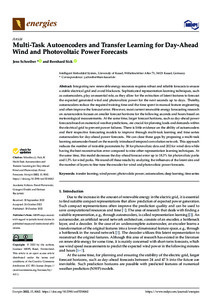| dc.date.accessioned | 2022-11-14T13:10:26Z | |
| dc.date.available | 2022-11-14T13:10:26Z | |
| dc.date.issued | 2022-10-30 | |
| dc.identifier | doi:10.17170/kobra-202211147108 | |
| dc.identifier.uri | http://hdl.handle.net/123456789/14248 | |
| dc.description.sponsorship | Gefördert durch den Publikationsfonds der Universität Kassel | |
| dc.language.iso | eng | |
| dc.rights | Namensnennung 4.0 International | * |
| dc.rights.uri | http://creativecommons.org/licenses/by/4.0/ | * |
| dc.subject | transfer learning | eng |
| dc.subject | wind power | eng |
| dc.subject | photovolatic power | eng |
| dc.subject | autoencoders | eng |
| dc.subject | deep learning | eng |
| dc.subject | time series | eng |
| dc.subject.ddc | 620 | |
| dc.title | Multi-Task Autoencoders and Transfer Learning for Day-Ahead Wind and Photovoltaic Power Forecasts | eng |
| dc.type | Aufsatz | |
| dcterms.abstract | Integrating new renewable energy resources requires robust and reliable forecasts to ensure a stable electrical grid and avoid blackouts. Sophisticated representation learning techniques, such as autoencoders, play an essential role, as they allow for the extraction of latent features to forecast the expected generated wind and photovoltaic power for the next seconds up to days. Thereby, autoencoders reduce the required training time and the time spent in manual feature engineering and often improve the forecast error. However, most current renewable energy forecasting research on autoencoders focuses on smaller forecast horizons for the following seconds and hours based on meteorological measurements. At the same time, larger forecast horizons, such as day-ahead power forecasts based on numerical weather predictions, are crucial for planning loads and demands within the electrical grid to prevent power failures. There is little evidence on the ability of autoencoders and their respective forecasting models to improve through multi-task learning and time series autoencoders for day-ahead power forecasts. We can close these gaps by proposing a multi-task learning autoencoder based on the recently introduced temporal convolution network. This approach reduces the number of trainable parameters by 38 for photovoltaic data and 202 for wind data while having the best reconstruction error compared to nine other representation learning techniques. At the same time, this model decreases the day-ahead forecast error up to 18.3% for photovoltaic parks and 1.5% for wind parks. We round off these results by analyzing the influences of the latent size and the number of layers to fine-tune the encoder for wind and photovoltaic power forecasts. | eng |
| dcterms.accessRights | open access | |
| dcterms.creator | Schreiber, Jens | |
| dcterms.creator | Sick, Bernhard | |
| dc.relation.doi | doi:10.3390/en15218062 | |
| dc.subject.swd | Windenergie | ger |
| dc.subject.swd | Erneuerbare Energien | ger |
| dc.subject.swd | Fotovoltaik | ger |
| dc.subject.swd | Deep learning | ger |
| dc.subject.swd | Codierung | ger |
| dc.subject.swd | Wettervorhersage | ger |
| dc.subject.swd | Elektrizitätsversorgungsnetz | ger |
| dc.type.version | publishedVersion | |
| dcterms.source.identifier | eissn:1996-1073 | |
| dcterms.source.issue | Issue 21 | |
| dcterms.source.journal | Energies | eng |
| dcterms.source.volume | Volume 15 | |
| kup.iskup | false | |
| dcterms.source.articlenumber | 8062 | |


